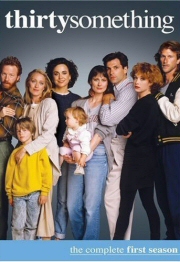Melanie Mayron, Polly Draper
- Drama
- 1987
- Buy the DVD
Reviewed by Ross Ruediger
()
n September of 1987, I was a couple months away from my 16th birthday, and you can be damned sure that there was no series on television that looked less interesting to me than “thirtysomething.” The title, which wasn’t exactly reaching out to my age group, was only part of the problem. The ads seemingly showcased a series about a group of yuppie scum of whom I had no interest whatsoever in following the adventures. So not only did I not watch the show in its first season, but I never even caught a single episode of it during its entire four-year run. But now I am thirtysomething – 37, in fact, which I believe makes me even a few years older than the show’s characters – and with this brand new DVD set and a gig as a reviewer of such material, it seemed like the time was right to give this show that earned my teenage scorn all those years ago a real chance.
What do you know? “thirtysomething” is actually pretty good stuff, and not at all comprised of the yuppie scum I’d always assumed – or, at least, not the yuppie scum I’d envisioned in my youth. I’m not sure that I even knew what a yuppie was when I was a teenager, only that they were not what I was supposed to turn into. It’s noteworthy that one of the show’s writers says in this set’s rather substantial extras section that the intention was never to make a show about yuppies; indeed, if someone had ever accused him of working on a show about yuppies, he probably would’ve punched them in the face.
Almost every article I’ve read about “thirtysomething” uses the word “whiny” to describe the characters, and usually pretty quickly, too. I suppose the characters are somewhat whiny, but not in a way that’s any more irritating than dozens and dozens of other characters I’ve seen on TV in the last 20 years. If talking about your daily problems is whiny, then so be it. As near as I can glean, “thirtysomething” was a major trendsetter for network television, and it probably changed the landscape of the medium just as much as “Twin Peaks” did a couple years later, only in an entirely different way. It said it was OK for men to talk about their feelings. It realized that marriage isn’t always an easy ride. It took its characters into therapy. It made the concept of raising a baby central to the storyline. It does dream sequences, and loads of them, too. All of America may not have been watching “thirtysomething” over its four-year run, but I’m willing to bet most of Hollywood was.
The show, at least at the start, primarily revolves around married couple Michael (Ken Olin) and Hope (Mel Harris) and their baby girl, Janey. They’re a squeaky clean pair who only get angry with each other in brief spurts, happy by the time the end credits roll; they deal with typical problems like money, work, parents, and the occasional miscommunication. Then there’s Elliot (Timothy Busfield), Michael’s business partner in advertising, and his wife, Nancy (Patricia Wettig). Theirs is a different kind of marriage altogether: problematic and waiting to explode. Busfield and Wettig give easily the most engaging performances on the show, but that’s also because they’re given such good material with which to work. Then there are the three single friends: Melissa (Melanie Mayron), a hip, aspiring photographer and Michael’s cousin; Gary (Peter Horton), a college professor with a Peter Pan complex and Michael’s best friend; and Ellyn (Polly Draper), Hope’s best friend, and a career woman who ends up falling for her boss. Eventually every character gets their day in the sun, and even the season finale revolves far more around Ellyn than it does Michael and Hope.
The thing that intrigued me the most about this series is that it never really did what I expected it to do, given the set-ups at the start of each episode. It almost always manages to go places and explore topics in a manner that feels fresh and new, which is no mean feat for a show that’s 22 years old and rooted in a very specific time and place which would seem to be well past its expiration date. The show is just as funny as it is poignant, and its themes remain just as relevant today as they did back then. As much as I can get into a soap opera, this most certainly isn’t one. Each episode has a specific idea that it’s exploring, and the narrative doesn’t drone on and on from one episode to the next to form any kind of real arc, which makes for a nice change of pace given that so much TV drama these days requires you to watch the whole season to get anything out of it at all. (I never thought I’d complain about that aspect of modern TV, but there you have it.) Sure, the fashions are dated, sometimes the dream sequences feel a little forced, and from time to time an experimental episode will pop up that doesn’t work as well as the rest (“South by Southeast,” a Hitchcock homage falls pretty flat), but by and large there’s a whole lot to love in “thirtysomething,” especially if you are thirtysomething…or older. I can’t really imagine it appealing to a crowd much younger than that, though, and it just so happens that the 16 -ear-old living under the same roof as me had about as much patience for it as I would have had if I’d watched when I was his age.
Maybe when he’s thirtysomething he’ll give it a shot.
Special Features: Shout! Factory has delivered a pretty bang-up box set for this release, and both long-time fans and those new to the fold will find plenty to enjoy here. For starters, there’s a sweet little 36-page book enclosed, which in addition to a Season One episode guide, also features a letter from creative head honchos Marshall Herskovitz and Edward Zwick, alongside a couple essays that make for some really good reading. There are nine commentary tracks alternately featuring the creators, directors, writers and the stars. Finally there are six lengthy featurettes, which aren’t terribly varied in their presentation (they pretty much consist of interviews broken up by clips), but offer up opinions and insights from just about everyone involved in the making of the series. By the time you’re done watching all this stuff, you’ll know far more about “thirtysomething” than you ever thought there was to know.
You can follow us on Twitter and Facebook for content updates. Also, sign up for our email list for weekly updates and check us out on Google+ as well.













